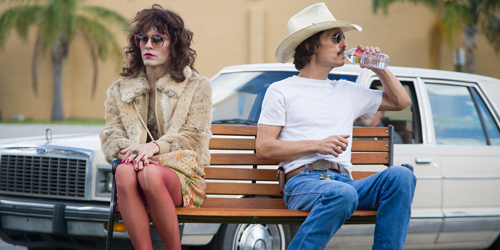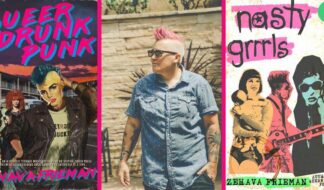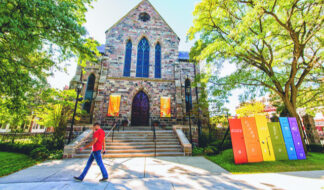
Photo: Focus Features
The AIDS crisis reached a devastating peak in the mid '80s, a time before cocktail therapies were sustaining life. Then, people were diagnosed and dead within days.
Ron Woodroof should've been.
The party boy, who was given just 30 days to live after he contracted HIV in 1986, defied the odds - and, by smuggling anti-viral medications from across the globe into the U.S., helped others do the same.
"The hard truth that I could see, and the way I approached it, was him getting HIV is what gave him his purpose in life," says Matthew McConaughey from the Four Seasons Los Angeles at Beverly Hills, still looking slender after dropping 40 pounds to play Woodroof in the critically acclaimed dramedy "Dallas Buyers Club." "That's the first time that he had something that he grabbed ahold to for 24 hours a day, seven days a week, every day, until he was here no longer. That's where he found a real identity. That's where he found a purpose."
Jean-Marc Vallee, director of "C.R.A.Z.Y." and "The Young Victoria," tells the Texas cowboy's story in this dramatized adaptation of his inspiring evolution from hard-edged homophobe to unlikely hero - and all from the perspective of a heterosexual man who thought only gay people got HIV.
"He doesn't start off as this crusader for the cause," McConaughey says. "He's not waving the flag. If anything, he's a selfish son of a bitch who's doing what he can to survive."
To find that fortitude, McConaughey channeled a buddy's real-life battle with cancer. "He had a lot of similar instincts, fight and characteristics that Ron had," he says. "I secretly had some of this based on this guy and the way he was fighting against cancer."
Using a friend to inspire his performance - along with Woodroof's diary, which the actor considered to be his "Pandora's box" - McConaughey tapped into Ron's humanity, says Vallee. "When he portrays a guy who's racist and homophobic, and then his arc changes slowly but surely without even realizing it - he's going to become the spokesperson of the gay community he's been bashing for years and years - that's what (McConaughey) brought naturally."
As he becomes a crusader for advancements in HIV medicine and the gay community, Woodroof's journey leads him to Rayon (Jared Leto, who won our hearts in the mid '90s during his "My So-Called Life" stint), an HIV-positive trans woman with just enough spunk to stand up to Woodroof's narrow-minded machismo. "Rayon is quick to love and fall in love," Leto says. "She's full of grace and charm and a huge, open heart, and Ron provides some kind of a father figure. She was shunned by her father at a very young age and, in a lot of ways, Ron provided that father figure, that big brother - and there was a lot of love there."
Vallee shares that sentiment, noting a scene where Woodroof sticks up for Rayon. "This is a love story between two guys," he says, "and we're not telling that, and it's not really about that, but these guys love each other." He pauses, laughing about the possibility of taking their relationship one or maybe two steps further. "I was asking myself, 'Should we hint to the audience that maybe they'll have sex together?'"
Leto's 'role of a lifetime'
So how did Jared Leto fare in heels? "I was a bit of a natural, to tell you the truth," he laughs. "Size 12, baby!"
The reason for that, and it's just now dawning on Leto: This ain't his first time at the rodeo. "I forgot about this, but there was another project years ago - I forgot what it was for - where I went and auditioned in drag for another film and walked down Fifth Avenue and thought I would have everybody fooled. But nope, nobody was having it."
In "Dallas Buyers Club," every time Leto slipped into those heels, he slipped right into Rayon. And he did it often.
"Every morning when I showed up on set - it didn't matter how exhausted I was - I always stepped out of that van, that glorious passenger van, in my heels," he says. "That was one of the little things that helped me lock into the character."
The transformation, though, involved more than shoes.
"You practice," he says. "It's one of the reasons why I was in character for the entire course of shooting, so I could get as much time in her skin as possible. But there was a lot going on. There was the gender. There was the voice. There was the dialect. There were the heels. There was the waxing. There were all kinds of things that made it a really unique experience."
He also had another priority: Embrace her as a sexual being.
"Oftentimes, you see this role in a film and it's a punch line, it's a bit of a stereotype, and it's also a safe choice for a lot of people," he says. "It's a role that doesn't have a lot of sexuality. I mean, the character isn't sexualized. And to me, I thought it was important not to be scared of that part."
And though the heels came easy, his biggest concern was avoiding caricature pitfalls and "representing (her) with dignity and grace."
As a "young creative kid," Leto was surrounded by a diverse circle - including transgender folks - while living city life in New York and LA. "I think that the people come to these cities to be who they really are, and you certainly come across people of all shapes and sizes and desires (who are) living their dreams as they wish them to be. That's what's so great about them."
But before securing the role of Rayon, Leto wanted to dig deeper. To do so, he met with young trans kids to discuss their challenges - and to give him a better understanding of what life looks like for transgender people. He calls that time with these teens "impactful."
"For me, it was important to identify with the desire to get to know oneself - one's true self - because that's what identity is really about," Leto says. "It goes even beyond gender. It's who are you in your heart, and how do you express who you are? And Rayon was in a process of discovery as well. She was finding out who she really was and certainly wanted to live her life as a woman and identify with that. So, (for me, it was) a really beautiful experience and a role of a lifetime."
Behind the scenes it was too. Leto recalls dancing and laughing at a bar after the cameras stopped rolling. Was it a gay bar in real life, too?
"Well, if it wasn't before, it is now," he says, laughing. "We certainly had a good time there. It was wild. It was toward the end - I think it was my last day - and I just kind of let loose."
Having minimal time to mingle during the intense 25-day shoot, McConaughey remembers it a little differently: "I gotta tell you, I had blinders on." But he chuckles when asked how immersed he got with the gays.
"Well, pretty immersed in those bars!"










